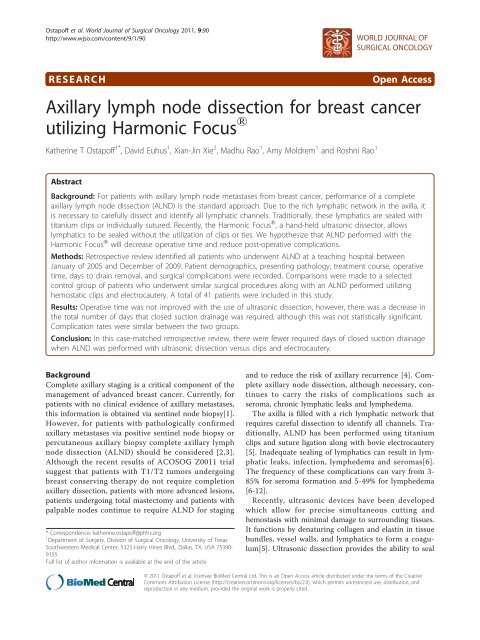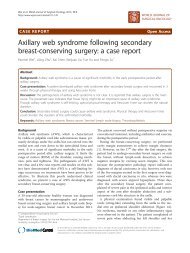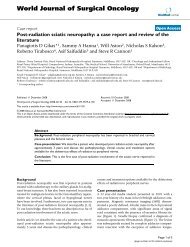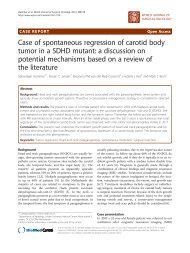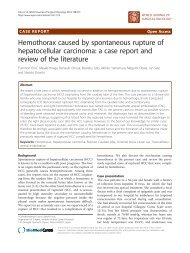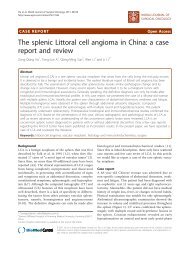Axillary lymph node dissection for breast cancer utilizing Harmonic ...
Axillary lymph node dissection for breast cancer utilizing Harmonic ...
Axillary lymph node dissection for breast cancer utilizing Harmonic ...
You also want an ePaper? Increase the reach of your titles
YUMPU automatically turns print PDFs into web optimized ePapers that Google loves.
Ostapoff et al. World Journal of Surgical Oncology 2011, 9:90http://www.wjso.com/content/9/1/90WORLD JOURNAL OFSURGICAL ONCOLOGYRESEARCHOpen Access<strong>Axillary</strong> <strong>lymph</strong> <strong>node</strong> <strong>dissection</strong> <strong>for</strong> <strong>breast</strong> <strong>cancer</strong><strong>utilizing</strong> <strong>Harmonic</strong> Focus ®Katherine T Ostapoff 1* , David Euhus 1 , Xian-Jin Xie 2 , Madhu Rao 1 , Amy Moldrem 1 and Roshni Rao 1AbstractBackground: For patients with axillary <strong>lymph</strong> <strong>node</strong> metastases from <strong>breast</strong> <strong>cancer</strong>, per<strong>for</strong>mance of a completeaxillary <strong>lymph</strong> <strong>node</strong> <strong>dissection</strong> (ALND) is the standard approach. Due to the rich <strong>lymph</strong>atic network in the axilla, itis necessary to carefully dissect and identify all <strong>lymph</strong>atic channels. Traditionally, these <strong>lymph</strong>atics are sealed withtitanium clips or individually sutured. Recently, the <strong>Harmonic</strong> Focus ® , a hand-held ultrasonic dissector, allows<strong>lymph</strong>atics to be sealed without the utilization of clips or ties. We hypothesize that ALND per<strong>for</strong>med with the<strong>Harmonic</strong> Focus ® will decrease operative time and reduce post-operative complications.Methods: Retrospective review identified all patients who underwent ALND at a teaching hospital betweenJanuary of 2005 and December of 2009. Patient demographics, presenting pathology, treatment course, operativetime, days to drain removal, and surgical complications were recorded. Comparisons were made to a selectedcontrol group of patients who underwent similar surgical procedures along with an ALND per<strong>for</strong>med <strong>utilizing</strong>hemostatic clips and electrocautery. A total of 41 patients were included in this study.Results: Operative time was not improved with the use of ultrasonic <strong>dissection</strong>, however, there was a decrease inthe total number of days that closed suction drainage was required, although this was not statistically significant.Complication rates were similar between the two groups.Conclusion: In this case-matched retrospective review, there were fewer required days of closed suction drainagewhen ALND was per<strong>for</strong>med with ultrasonic <strong>dissection</strong> versus clips and electrocautery.BackgroundComplete axillary staging is a critical component of themanagement of advanced <strong>breast</strong> <strong>cancer</strong>. Currently, <strong>for</strong>patients with no clinical evidence of axillary metastases,this in<strong>for</strong>mation is obtained via sentinel <strong>node</strong> biopsy[1].However, <strong>for</strong> patients with pathologically confirmedaxillary metastases via positivesentinel<strong>node</strong>biopsyorpercutaneous axillary biopsy complete axillary <strong>lymph</strong><strong>node</strong> <strong>dissection</strong> (ALND) should be considered [2,3].Although the recent results of ACOSOG Z0011 trialsuggestthatpatientswithT1/T2tumorsundergoing<strong>breast</strong> conserving therapy do not require completionaxillary <strong>dissection</strong>, patients with more advanced lesions,patients undergoing total mastectomy and patients withpalpable <strong>node</strong>s continue to require ALND <strong>for</strong> staging* Correspondence: katherine.ostapoff@phhs.org1 Department of Surgery, Division of Surgical Oncology, University of TexasSouthwestern Medical Center, 5323 Harry Hines Blvd., Dallas, TX, USA 75390-9155Full list of author in<strong>for</strong>mation is available at the end of the articleand to reduce the risk of axillary recurrence [4]. Completeaxillary <strong>node</strong> <strong>dissection</strong>, although necessary, continuesto carry the risks of complications such asseroma, chronic <strong>lymph</strong>atic leaks and <strong>lymph</strong>edema.The axilla is filled with a rich <strong>lymph</strong>atic network thatrequires careful <strong>dissection</strong> to identify all channels. Traditionally,ALND has been per<strong>for</strong>med using titaniumclips and suture ligation along with bovie electrocautery[5]. Inadequate sealing of <strong>lymph</strong>atics can result in <strong>lymph</strong>aticleaks, infection, <strong>lymph</strong>edema and seromas[6].The frequency of these complications can vary from 3-85% <strong>for</strong> seroma <strong>for</strong>mation and 5-49% <strong>for</strong> <strong>lymph</strong>edema[6-12].Recently, ultrasonic devices have been developedwhich allow <strong>for</strong> precise simultaneous cutting andhemostasis with minimal damage to surrounding tissues.It functions by denaturing collagen and elastin in tissuebundles, vessel walls, and <strong>lymph</strong>atics to <strong>for</strong>m a coagulum[5].Ultrasonic <strong>dissection</strong> provides the ability to seal© 2011 Ostapoff et al; licensee BioMed Central Ltd. This is an Open Access article distributed under the terms of the CreativeCommons Attribution License (http://creativecommons.org/licenses/by/2.0), which permits unrestricted use, distribution, andreproduction in any medium, provided the original work is properly cited.
Ostapoff et al. World Journal of Surgical Oncology 2011, 9:90http://www.wjso.com/content/9/1/90Page 2 of 5vascular and <strong>lymph</strong>atic conduits with limited collateraldamage.The <strong>Harmonic</strong> Focus ® is a handheld ultrasonic <strong>dissection</strong>device which allows <strong>lymph</strong>atics to be sealed withoututilization of clips or ties. It has been available sinceOctober 2007 and is designed <strong>for</strong> open procedures. Ithas been used <strong>for</strong> <strong>dissection</strong> in surgery of the liver, gallbladder,thyroid and <strong>breast</strong> [13-18]. It has been used inother <strong>lymph</strong>atic <strong>dissection</strong>s in an attempt to reduce<strong>lymph</strong>atically related complications and has been shownto reduce operative times and reduce <strong>lymph</strong>atic spillagewith similar rates of <strong>lymph</strong> <strong>node</strong> harvest <strong>for</strong> both modifiedlateral neck <strong>dissection</strong>s and central neck <strong>dissection</strong>sin thyroid <strong>cancer</strong>[16,17]. The ultrasonic dissector hasalso been shown to reduce blood loss[12].We hypothesize that ALND per<strong>for</strong>med with <strong>Harmonic</strong>Focus ® will decrease operative time and post-operativecomplications. Here we present our pilot study investigatingthe role of <strong>Harmonic</strong> Focus ® as method toreduce axillary complications.MethodsAll women at the University of Texas SouthwesternMedical Center undergoing ALND <strong>for</strong> confirmed <strong>breast</strong><strong>cancer</strong> metastasis from January 1, 2005 to December 1,2009 were eligible. Nearly 250 ALND’s were per<strong>for</strong>medduring this time period. In 2007, ultrasonic <strong>dissection</strong>became the standard technique <strong>for</strong> ALND <strong>for</strong> 3 fellowshiptrained <strong>breast</strong> surgeons (RR, AM, DE) at this large,high volume, academic medical center. Twenty eightpatients underwent ALND with the <strong>Harmonic</strong> ® scalpel.Patient records were reviewed after IRB approval. Thesepatients were then matched <strong>for</strong> number and type of proceduresper<strong>for</strong>med at the time of ALND with thirteenhistorical case controls by procedure per<strong>for</strong>med by thesame surgeons. All patients had pathologically confirmedaxillary metastasis prior to ALND by either sentinel<strong>node</strong> biopsy or percutaneous axillary biopsy.Additionally, none of the patients in either group had<strong>breast</strong> reconstruction at the time of axillary <strong>dissection</strong>.Due to the surgeon preference <strong>for</strong> <strong>utilizing</strong> ultrasonic<strong>dissection</strong> once it became available, one to one matchedpair analysis was not possible, however, the thirteencontrols reviewed were per<strong>for</strong>med by the same surgeonsthat per<strong>for</strong>med the ultrasonic <strong>dissection</strong>s to minimizesurgeon specific variables.SurgerySkin incisions were made with a scalpel. If concurrent<strong>breast</strong> surgery occurred at the time of ALND, mastectomywas per<strong>for</strong>med using either tumescent technique orbovie electrocautery. For axillary <strong>lymph</strong>adenectomy, alltissue inferior to the axillary vein, between the anteriorborder of the latissimus dorsi and medial to the borderof the pectoralis minor was removed, thus including alllevel 1 and 2 <strong>node</strong>s. The axilla was closed with 3.0Vicryl interrupted suture and the skin was re-approximatedwith 4.0 Monocryl. At the time of surgery, 1closed suction 19 french Jackson-Pratt drain was placed<strong>for</strong> patients with partial mastectomy and axillary <strong>dissection</strong>and 2 closed suction drains were placed <strong>for</strong> modifiedradical mastectomy patients. Drains were thenremoved on an outpatient basis when output was lessthan 30 cc/day <strong>for</strong> 2 consecutive days. Operative timewas obtained by review of the anesthesia record andoperating room nurse record. Patients were dischargedroutinely on postoperative day one with drains in placeand self recorded the output after teaching.Incidence of ipsilateral <strong>lymph</strong>edema, seroma andwound complications was noted upon review of followupappointments in any department (Surgery/RadiationOncology, Medical Oncology or Emergency department).Categorical variables were analyzed using c 2 test,continuous variables were analyzed using ANOVA testingusing SPSS 12.0. All endpoint analyses were analyzedusing paired t-test. Multiple comparisons were notadjusted <strong>for</strong>.ResultsOver the 2 year period, 28 patients underwent axillary<strong>dissection</strong> using <strong>Harmonic</strong> scalpel ® .Medianfollow-uptime <strong>for</strong> both groups was 2.0 years. Patients in bothgroups had similar demographicsaswellaspathologyand exposure to chemotherapy (Table 1). Additionally,there was no statistically significant difference in T stagebetween the control and ultrasonic <strong>dissection</strong> group (p= 0.222). Patients were matched to controls undergoingsimilar procedures by the same surgeons (Table 2).There were no differences in operative time, postoperativeday 1 output or overall complications betweenthegroups.Therewasadifferenceindaystodrainremoval (15.9 vs 12.4 days p = 0.07), however, this wasnot statistically significant. There was no difference inrates of seromas, wound complications or <strong>lymph</strong>edemabetween the two groups (Table 3).DiscussionGiven the significant morbidity of ALND and the costsassociated with their management, multiple studies havetried to identify risks factors as well as methods toreduce complications. Risk factors <strong>for</strong> seroma <strong>for</strong>mationinclude MRM rather than PM[9], use of electrocautery<strong>for</strong> ALND[19], older age, patient weight, BMI[20] anddrainage output at 48 hours (>50 cc/day)[21]. The roleof axillary drainage has been a particular area of focus.Drains have been shown to reduce seroma rates comparedto no drainage at all[21-23]. Lower overall drainvolume[24], days to drain removal[25,26] and drainage
Ostapoff et al. World Journal of Surgical Oncology 2011, 9:90http://www.wjso.com/content/9/1/90Page 4 of 5analysis that risk factors <strong>for</strong> seroma <strong>for</strong>mation includedBMI, tumor size, number of involved <strong>node</strong>s, total drainagebe<strong>for</strong>e drain removal and time to drain removal[38].This is the first investigation in an American institution,evaluating the use of the <strong>Harmonic</strong> Focus ® toreduce complications <strong>for</strong> ALND. Adwani et al founddecreased blood loss but no difference in days untildrain removal, seroma <strong>for</strong>mation or number of treatments<strong>for</strong> seromas, and were thus unable to showimproved outcomes in England[18]. An Indian studysimilarly found reduced blood loss but also foundreduced drainage volume and drainage days but foundno difference in seroma <strong>for</strong>mation or operative time(seroma rate 16% vs 22%)[39]. Manouras et al in Greecefound no complications with the use of the <strong>Harmonic</strong> ®scalpel <strong>for</strong> ALND in 60 patients at 3 years of follow-up[40].Althoughimpressive,only 22% of these patientshad positive <strong>node</strong>s, a factor which has been shown toincrease the risk <strong>for</strong> axillary complications. Additionally,comparisons may be difficult as the majority of thesepatients had lower stage tumors (5% T3) than the presentstudy[41].We found fewer days to drain removal with the use ofultrasonic <strong>dissection</strong>. Although there was no differencein operative time, seroma <strong>for</strong>mation, wound complicationsor <strong>lymph</strong>edema, reduced drainage time has beenshown to reduce complication rates[20]. Larger studieswith increased statistical power may be able to detectother differences. Many of our patients had bilateralprocedures done at the time of ALND with and withoutimmediate reconstruction, which increases expectedoperative times and increases the risk of complications.The <strong>Harmonic</strong> ® scalpel, in addition to reducing thedays of drain placement, can also potentially reducehealthcare costs. Fewer days of drainage can reduce thenumber of clinic visits and potentially the need <strong>for</strong> additionalstudies. Also, there is a potential <strong>for</strong> reducedcosts of equipment given that thecurrentinstitutionalcost of an automatic clip applier is $185, with the use of2-3 per case and the <strong>Harmonic</strong> Focus ® is approximately$400.By allowing faster removal of closed suction drainageafter ALND, <strong>Harmonic</strong> focus ® may allow a more rapidtransition to the initiation of systemic therapy as suggestedby our pilot study.ConclusionsIn this retrospective, pilot study, the use of ultrasonic<strong>dissection</strong> resulted in trends suggesting decreased daysof closed suction drainage when compared to traditionaltechniques <strong>utilizing</strong> clips and electrocautery. Ultrasonic<strong>dissection</strong> was not associated with decreased operativetime or lower rates of post-operative complications.Further studies with larger sample sizes are required toconfirm these results.AbbreviationsALND: axillary <strong>lymph</strong> <strong>node</strong> <strong>dissection</strong>; PM: partial mastectomy; TM: totalmastectomy; SLNB: sentinel <strong>lymph</strong> <strong>node</strong> biopsy; BMI: body mass index.AcknowledgementsThe authors would like to thank Victoria Warren, Fiemu Nwariaku MD andThe David M. Crowley Foundation <strong>for</strong> their assistance with this study.Author details1 Department of Surgery, Division of Surgical Oncology, University of TexasSouthwestern Medical Center, 5323 Harry Hines Blvd., Dallas, TX, USA 75390-9155.2 Department of Clinical Sciences, University of Texas SouthwesternMedical Center, 5323 Harry Hines Blvd., Dallas, TX, USA 75390-9155.Authors’ contributionsKO: study concept and design, data acquisition, analysis and interpretationof data, drafting of manuscript, critical revision, DE: critical revision, patients,XX: analysis and interpretation of data, critical revision, MR: cost analysis,critical revision, AM: critical revision, patients RR: study concept and design,data acquisition, patients, analysis and interpretation of data, drafting ofmanuscript, critical revision. The authors have reviewed this manuscript andagree with its contents in its final <strong>for</strong>m.Competing interestsThe authors declare that they have no competing interests.Received: 23 February 2011 Accepted: 15 August 2011Published: 15 August 2011References1. Krag DN, Anderson SJ, Julian TB, Brown AM, Harlow SP, Costantino JP,Ashikaga T, Weaver DL, Mamounas EP, Jalovec LM, Frazier TG, Noyes RD,Robidoux A, Scarth HM, Wolmark N: Sentinel-<strong>lymph</strong>-<strong>node</strong> resectioncompared with conventional axillary-<strong>lymph</strong>-<strong>node</strong> <strong>dissection</strong> in clinical<strong>node</strong>-negative patients with <strong>breast</strong> <strong>cancer</strong>: overall survival findings fromNSABP B-32 randomized phase 3 trial. Lancet Oncol 2010, 11(10):927-33.2. Krag DN, Anderson SJ, Julian TB, Brown AM, Harlow SP, Ashikaga T,Weaver DL, Miller BJ, Jalovec LM, Frazier TG, Noyes RD, Robidoux A,Scartch HM, Mammolito DM, McCready DR, Mamounas EP, Costantino JP,Wolmark N, National Surgical Adjuvant Breast and Bowel Project: Technicaloutcomes of sentinel-<strong>lymph</strong>-<strong>node</strong> resection and conventional axillary<strong>lymph</strong>-<strong>node</strong><strong>dissection</strong> in patients with clinical <strong>node</strong>-negative patientswith <strong>breast</strong> <strong>cancer</strong>: overall survival findings from NSABP B-32randomized phase 3 trial. Lancet Oncol 2007, 8(10):881-8.3. Carlson RW, Allred DC, Anderson BO, Burstein HJ, Carter WB, Edge SB,Erban JK, Farrar WB, Goldstein LJ, Gradishar WJ, Hayes DF, Hudis CA,Jahanzeb M, Kiel K, Ljung BM, Marcom PK, Mayer IA, McCormick B,Nabell LM, Pierce LJ, Reed EC, Smith ML, Somlo G, Theriault RL, Topham NS,Ward JH, Winer EP, Wolff AC, NCCN Breast Cancer Clinical PracticeGuidelines Panel: Breast <strong>cancer</strong>. Clinical practice guidelines in oncology. JNatl Compr Canc Netw 2009, 7(2):122-92.4. Giuliano AE, Hunt KK, Ballman KV, Beitsch PD, Whitworth PW,Blumencranz PW, Leitch AM, Saha S, McCall LM, Morrow M: <strong>Axillary</strong><strong>dissection</strong> vs no axillary <strong>dissection</strong> in women with invasive <strong>breast</strong><strong>cancer</strong> and sentinel <strong>node</strong> metastasis: a randomized clinical trial. JAMA2011, 305(6):569-75.5. Brill AI: Bipolar electrosurgery: convention and innovation. Clin ObstetGynecol 2008, 51:153-8.6. Vitug AF, Newman LA: Complications in <strong>breast</strong> surgery. Surg Clin NorthAm 2007, 87:431-51.7. Coveney EC, O’Dwyer PJ, Geraghty JG, O’Higgins NJ: Effect of closing deadspace on seroma <strong>for</strong>mation after mastectomy-a prospective randomizedclinical trial. Eur J Surg Oncol 1993, 19:143-146.8. Anand R, Skinner R, Dennison G, Pain JA: A prospective randomized trialof two treatments <strong>for</strong> wound seroma after <strong>breast</strong> surgery. Eur J SurgOncol 2002, 28:483-487.
Ostapoff et al. World Journal of Surgical Oncology 2011, 9:90http://www.wjso.com/content/9/1/90Page 5 of 59. Gonzalez EA, Saltzstein EC, Riedner CS, Nelson BK: Seroma <strong>for</strong>mationfollowing <strong>breast</strong> <strong>cancer</strong> surgery. Breast J 2003, 5:385-8.10. Woodworth PA, McBoyle MF, Helmer SD, Beamer RL: Seroma <strong>for</strong>mationafter <strong>breast</strong> <strong>cancer</strong> surgery: incidence and predicting factors. Am Surg2000, 66:444-50.11. Goldberg JS, Wiechmann LI, Riedel ER, Morrow M, Van Zee KJ: Morbidity ofsentinel <strong>node</strong> biopsy in <strong>breast</strong> <strong>cancer</strong>: the relationship between thenumber of excised <strong>lymph</strong> <strong>node</strong>s and <strong>lymph</strong>edema. Ann Surg Oncol 2010,17:3278-86.12. Petrek JA, Senie RT, Peters M, Rosen PP: Lymphedema in a cohort of<strong>breast</strong> carcinoma survivors after 20 years after diagnosis. Cancer 2001,92(6):1368-1377.13. Cheang T, Hanna SS, Wright FC, Law CH: Use of collagen-sealing device inhepatic resection: a comparative analysis to standard resectiontechnique. HPB(Ox<strong>for</strong>d) 2006, 8:194-9.14. Gelmini R, Franzoni C, Zona S, Andreotti A, Saviano M: Laparoscopiccholecystectomy with harmonic scalpel. JSLS 2010, 14(1):14-9.15. Kandil T, El Nakeeb A, El Hefnawy E: Comparative study between cliplesslaparoscopic cholecystectomy by harmonic scalpel versus conventionalmethod: a prospective randomized study. J Gastrointest Surg 2010,14:323-8.16. Koh YW, Park JH, Lee SW, Choi EC: The harmonic scalpel techniquewithout supplementary ligation in total thyroidectomy with central neck<strong>dissection</strong>. Ann Surg 2008, 247:945-49.17. Miccoli P, Materazzi G, Fregoli L, Panicucci E, Kunz-Martinez W, Berti P:Modified lateral neck <strong>lymph</strong>adenectomy: prospective randomized studycomparing harmonic scalpel with clamp-and-tie technique.Otolaryngology 2009, 140:61-4.18. Adwani A, Ebbs SR: Ultracision reduces acute blood loss but not seroma<strong>for</strong>mation after mastectomy and axillary <strong>dissection</strong>: a pilot study. Int JClin Pract 2006, 60:562-564.19. Porter K, O’Connor S, Rimm E, Lopez M: Electrocautery as a factor inseroma <strong>for</strong>mation following mastectomy. Am J Surg 1998, 176:8-14.20. Unalp HR, Onal MA: Analysis of risk factors affecting the development ofseromas following <strong>breast</strong> <strong>cancer</strong> surgeries: seromas following <strong>breast</strong><strong>cancer</strong> surgeries. Breast J 2007, 13:588-92.21. Burak WE Jr, Goodman PS, Young DC, Farrar WB: Seroma <strong>for</strong>mationfollowing axillary <strong>dissection</strong> <strong>for</strong> <strong>breast</strong> <strong>cancer</strong>: risk factors and lack ofinfluence of bovine thrombin. J Surg Onc 1997, 64:27-31.22. Divino CM, Kuerer HM, Tartter PI: Drains prevent seromas followinglumpectomy with axillary <strong>dissection</strong>. Breast J 2000, 6:31-33.23. Cameron AE, Ebbs SR, Wylie F, Baum M: Suction drainage of the axilla: aprospective randomized trial. Br J Surg 1988, 75:1211.24. Soon PS, Clark J, Magarey CJ: Seroma <strong>for</strong>mation after axillary<strong>lymph</strong>adenectomy with and without the use of drains. Breast 2005,14:103-7.25. Barwell J, Campbell L, Watkins RM, Teasdale C: How long should suctiondrains stay in after <strong>breast</strong> surgery with axillary <strong>dissection</strong>? Ann R CollSurg Engl 1997, 79:435-7.26. Kopelman D, Klemm O, Bahous H, Klein R, Krausz M, Hashmonai M:Postoperative suction drainage of the axilla: <strong>for</strong> how long? prospectiverandomized trial. Eur J Surg 1999, 2:117-20.27. Vinton AL, Traverso LW, Jolly PC: Wound complications after modifiedradical masectomy compared with tylectomy with axillary <strong>lymph</strong> <strong>node</strong><strong>dissection</strong>. Am J Surg 1991, 161:584-8.28. Cipolla C, Fricano S, Vieni S, Graceffa G, Licari G, Torcivia A, Latteri MA: Doesthe use of fibrin glue prevent seroma <strong>for</strong>mation after axillary<strong>lymph</strong>adenectomy <strong>for</strong> <strong>breast</strong> <strong>cancer</strong>? A prospective randomized trial in159 patients. J Surg Onc 2010, 101:600-3.29. Berger A, Tempfer C, Hartmann B, Kornprat P, Rossmann A, Neuwirth G,Tulusan A, Kubista E: Sealing of postoperative axillary leakage afteraxillary <strong>lymph</strong>adenectomy using fibrin glue coated collagen patch: aprospective randomized study. Breast Cancer Res Treat 2001, 67(1):9-14.30. Kerin MJ, O’Hanlon DM, Kenny P, Kent PJ, Given HF: Argon-enhancedcutting and coagulation confers advantages over conventionalelectrocautery <strong>for</strong> mastectomy. Eur J Surg Onc 1996, 22:571-3.31. Classe JM, Berchery D, Campion L, Pioud R, Dravet F, Robard S:Randomized clinical trial comparing axillary padding with closed suctiondrainage <strong>for</strong> the axillary wound after <strong>lymph</strong>adenectomy <strong>for</strong> <strong>breast</strong><strong>cancer</strong>. Br J Surg 2006, 93:820-4.32. Gong Y, Xu J, Shao J, Cheng H, Wu X, Zhao D, Xiong B: Prevention ofseroma <strong>for</strong>mation after masectomy and axillary <strong>dissection</strong> by <strong>lymph</strong>vessel ligation and dead space closure: a randomized trial. Am J Surg2010, 200:352-56.33. Noguchi M, Yokoi M, Nakano Y: <strong>Axillary</strong> reverse mapping withindocyanine fluorescence imaging in patients with <strong>breast</strong> <strong>cancer</strong>. J SurgOncol 2010, 101(3):217-21.34. Boneti C, Korourian S, Bland K, Cox K, Adkins LL, Henry-Tillman RS,Klimberg VS: <strong>Axillary</strong> reverse mapping: mapping and preserving arm<strong>lymph</strong>atics may be important in preventing <strong>lymph</strong>edema duringsentinel <strong>lymph</strong> <strong>node</strong> biopsy. J Am Coll Surg 2008, 206(5):1038-42.35. Boneti C, Korourian S, Diaz Z, Santiago C, Mum<strong>for</strong>d S, Adkins L,Klimberg VS: Scientific Impact Award: <strong>Axillary</strong> reverse mapping (ARM) toidentify and protect <strong>lymph</strong>atics draining the arm during axillary<strong>lymph</strong>adenectomy. Am J Surg 2009, 198(4):482-7.36. Boccardo FM, Casabona F, Friedman D, Puglisi M, De Cian F, Ansaldi F,Campisi C: Surgical Prevention of Arm Lymphedema After Breast CancerTreatment. Ann Surg Oncol 2011.37. Galatius H, Okholm M, Hoffmann J: Masectomy using ultrasonic<strong>dissection</strong>: effect on seroma <strong>for</strong>mation. Breast 2003, 12:338-341.38. Lumachi F, Brandes AA, Burelli P, Basso SM, Iacobone M, Ermani M: Seromaprevention following axillary <strong>dissection</strong> in patients with <strong>breast</strong> <strong>cancer</strong> byusing ultrasound scissors: a prospective clinical study. EJSO 2004,30:526-30.39. Deo SV, Shukla NK, Asthana S, Niranjan B, Srinivas G: A comparative studyof modified radical masectomy using harmonic scalpel andelectrocautery. Singapore Med J 2002, 43:226-8.40. Manouras A, Markogiannakis H, Genetzakis M, Filippakis GM,Lagoudianakis EE, Kafiri G, filis K, Zografos GC: Modified radicalmastectomy with axillary <strong>dissection</strong> using the electrothermal bipolarvessel sealing system. Arch Surg 2008, 6:575-79.41. McLaughlin SA, Wright MJ, Morris KT, Giron GL, Sampson MR, Brockway JP,Hurley KE, Riedel ER, Van Zee KJ: Prevalence of <strong>lymph</strong>edema in womenwith <strong>breast</strong> <strong>cancer</strong> 5 years after sentinel <strong>node</strong> biopsy or axillary<strong>dissection</strong>: objective measurements. JCO 2008, 32:5213-5219.doi:10.1186/1477-7819-9-90Cite this article as: Ostapoff et al.: <strong>Axillary</strong> <strong>lymph</strong> <strong>node</strong> <strong>dissection</strong> <strong>for</strong><strong>breast</strong> <strong>cancer</strong> <strong>utilizing</strong> <strong>Harmonic</strong> Focus ® ®. World Journal of SurgicalOncology 2011 9:90.Submit your next manuscript to BioMed Centraland take full advantage of:• Convenient online submission• Thorough peer review• No space constraints or color figure charges• Immediate publication on acceptance• Inclusion in PubMed, CAS, Scopus and Google Scholar• Research which is freely available <strong>for</strong> redistributionSubmit your manuscript atwww.biomedcentral.com/submit


